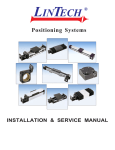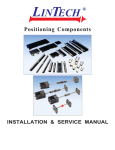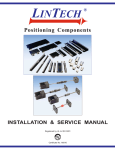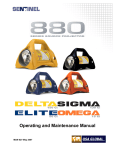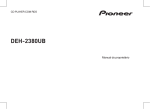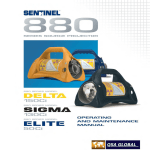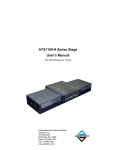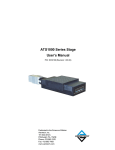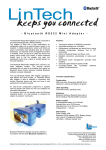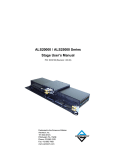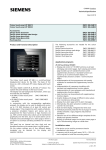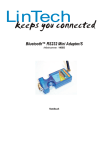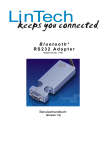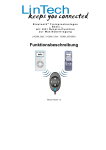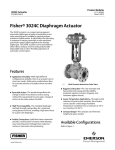Download Systems Service Manual
Transcript
LINTECH ® Positioning Systems Front Cover INSTALLATION & SERVICE MANUAL Welcome to LINTECH ® Our local technical support group consists of Automation Specialists located throughout the World. These Automation Specialists are experienced in the use of electronic and mechanical motion control products. They are well trained on the performance capabilities of LINTECH positioning components. LINTECH is constantly designing new products and improving upon the many options available with our standard products. Whether it is a standard or custom positioning system required, visit our website, call, or e-mail us. We look forward to hearing from you. Visit our website, or call us for the location of the nearest Automation Specialist in your area: LINTECH ® For over 44 years LINTECH has designed, engineered, and manufactured mechanical motion solutions for use in a wide range of applications. Whether it is a standard positioning component or a custom positioning system, LINTECH takes great pride in manufacturing a quality product. At LINTECH we are proud to provide the motion control user with this general product guide. It was developed to assist you with acquiring the general knowledge of what LINTECH has to offer. You can find complete details on all LINTECH products via our website. Toll Free: Phone: Fax: 1845 Enterprise Way Monrovia, CA. 91016 (800) 435 - 7494 (626) 358 - 0110 (626) 303 - 2035 Web Site: E-Mail: www.LintechMotion.com [email protected] Depending on the requirements, standard positioning components can often be assembled and shipped in less than 2 weeks. Custom positioning assemblies require a different approach. We evaluate your special application, use our many years of experience to guide you, and then manufacture a quality product designed to meet your performance specifications. LINTECH's technical support consists of a well trained inside customer service department, an experienced application engineering staff, and a versatile machining facility. version: 09/2015 Copyright© 2015 LINTECH ® www.LintechMotion.com LINTECH ® Table of Contents Service Manual Pages 2 Introduction Overview 3 Warranty & Returns Technical Assistance Standard Warranty Policy Return Policy Dimensions and Product Changes Specifications - Linear Positioning Systems 4-6 Load Capacity Drive Mechanism Types Maximum Carriage Speed Maximum Carriage Acceleration & Thrust Carriage & Table Base Deflection Motor Size & Mounting Installation - Linear Positioning Tables 6-9 Mounting Surface Requirements 110 Series Mounting Carriage & Table Base Modification Environmental Consideration Wiring Interface Maintenance - Linear Positioning Tables 10 - 14 Lubrication Recommended Lubrication Types Guidelines for Lubrication Lubrication - Standard Tables Additional Installation - Linear Positioning Tables - Belt Drives 15 - 17 120 Series 180 Series 550 Series 18 - 27 Options Motor Couplings Linear & Rotary Incremental Encoders Power-Off Electric Brakes End of Travel (EOT) & Home Switches Installation - Rotary Positioning Tables 28 - 29 300 Series 400 Series Terms of Sale LINTECH ® 31 www.LintechMotion.com 1 Introduction Service Manual Overview Thank you for purchasing a LINTECH positioning system. This manual provides you with important information about your system. It also points out some precautions which should be taken to ensure proper operation, and the longest possible life of your system. LINTECH manufactures both standard and custom positioning systems which are used in a wide variety of applications and industries. The chart below illustrates the different positioning system models available from LINTECH and some of their basic features. For a full description and details on your system, please refer to the LINTECH Positioning Systems catalog or your original quotation if a custom system was purchased. Every LINTECH positioning system will have a "NAME PLATE" attached somewhere to the system, indicating the Model & Serial numbers. If, for any reason, you need to contact LINTECH, or an Automation Specialist, please have ready the Model & Serial numbers of your positioning system, as this may speed the process of answering your question. Table Series Positioning Type Bearing Type Drive Type 90 linear round rail (shaft) screw (acme or ball) 100 linear square (profile) rail screw (acme or ball) 110 linear square (profile) rail screw (acme or ball) 120 linear square (profile) rail belt 130 linear square (profile) rail screw (acme or ball) 140 linear square (profile) rail belt 150 linear square (profile) rail screw (acme or ball) 200 linear square (profile) rail screw (acme or ball) 250 linear square (profile) rail screw (acme or ball) 160 linear square (profile) rail screw (acme or ball) 170 linear square (profile) rail screw (acme or ball) 180 linear square (profile) rail belt 300 rotary angular contact worm gear 400 rotary angular contact worm gear 550 linear square (profile) rail belt 610 linear square (profile) rail screw (acme or ball) Custom Positioning Systems - see individual quotations 2 www.LintechMotion.com LINTECH ® Warranty & Returns Service Manual Technical Assistance Please do not hesitate to call LINTECH with any questions you have. You may contact the Automation Specialist in your area for local help, visit our web site or call the factory direct. Either way, your satisfaction is our main concern. LINTECH 1845 Enterprise Way Monrovia, CA 91016 Toll Free: (800) 435 - 7494 Phone: (626) 358 - 0110 Fax: (626) 303 - 2035 Web Site: www.LintechMotion.com E-mail: [email protected] Standard Warranty Policy All LINTECH positioning systems are guaranteed to be free from defects in material and workmanship, under normal use, for a period of one year after date of shipment. This warranty covers the repair or replacement of a product when it is sent prepaid to LINTECH. LINTECH does not assume liability for installation, abuse, alteration, insufficient application data provided for a design, or misuse of any positioning system. Products furnished by LINTECH, but not manufactured by LINTECH (motors, gearheads, encoders, amplifiers, etc....), are subject to the manufacturers standard warranty terms and conditions. Return Policy Any product requiring a return to LINTECH (for warranty or non-warranty repair) requires pre-approval from the factory prior to shipment. Contact the customer service department at (800) 435-7494 in order to obtain a RMA (Return Materials Authorization) number. At that time, please have your system Model & Serial numbers available, along with the reason for the return. The RMA number should be clearly marked on the returned package label and your packing list, or shipping document. Return product freight prepaid in its original package, or one with comparable protection. LINTECH will not accept return shipments sent freight collect. Product damage incurred during return shipment, from poor packaging, will not be warranted by LINTECH. Keeping original packing materials is recommended until initial inspection & testing is completed. Dimensions and Product Changes Published dimensions shown in the Positioning Systems catalogs are known to be accurate at the time of printing. LINTECH shall not be held liable, under any circumstances, for any wrongly documented dimension or specification. Changes in design are made whenever LINTECH believes its product will improve by the change. No obligation to incorporate these changes in units manufactured prior to a change, will be assumed. LINTECH ® www.LintechMotion.com 3 Specifications Service Manual Load Capacity - Dynamic, Static, & Moment Loads It is very important to know the load capacity of your positioning table. If you purchased a standard catalog item, refer to the Positioning Systems catalog for load capacities. If a custom table was purchased, refer to your quote for the load rating. WARNING - exceeding the load capacity of your positioning table can result in table damage. Also, load ratings are based upon the utilization of ALL the carriage mounting holes for securing the load. If you are not sure what the load capacity of your positioning system is, please contact your local Automation Specialist or LINTECH. The dynamic horizontal load rating of a table is the amount of weight centered on the carriage that the table can support while moving. This value is rated for a specific travel life. If this value is exceeded, shorter travel life could result. Depending upon the application, this could mean the lead screw or linear bearings would need to be replaced before the rated travel life of the positioning system is reached. A static load occurs when a force is applied to the table carriage, with the carriage at zero speed. Typical static forces result from: drilling, grinding, pressing, cutting, welding, or even someone standing on the table. Exceeding the rated static load capacity of a table could result in structural damage to the positioning system. A Moment load occurs whenever the load center of gravity is not centered on the carriage, or when an external force is applied to the carriage (i.e. side, top, or pushing/pulling thrusts). All vertical, and side mounted applications are considered to be moment loads. See LINTECH's Positioning Systems catalogs for further description on these terms, values for a specific positioning table, load versus life equations, and recommended safety factors. Proper lubrication of the linear bearing system is required for any positioning table to achieve its expected travel life for a given amount of load capacity. Drive Mechanism - Screw Types - Acme & Ball The screw type is another factor influencing the life & performance of a linear positioning system. LINTECH uses both acme and ball screws. Acme screws provide smoother low speed operation, and will prevent load backdriving in most vertical applications (no carriage movement when motor power is removed). Ball screws allow for high speed, high duty cycle, longer life, and lower friction operation. Every screw has a load capacity associated with it based on the number of screw revolutions. Refer to the LINTECH Positioning Systems catalog for further description and details on screw types, load capacities and life. WARNING - Exceeding the load capacity of a screw, for a given life (number of screw revolutions), can cause mis-positioning problems, extra system backlash, and a rougher operating positioning system. Proper lubrication of the nut & screw assembly is required for any positioning table to achieve its expected travel life for a given amount of load capacity. Some screws are available with preloaded nuts, which eliminates backlash in an application. The preloading of the nut is accomplished several different ways. LINTECH DOES NOT recommend that an adjustment of the preload setting be done in the field. The positioning table should be returned to the factory for proper adjustment. For vertical applications, a power-off electric brake (activates when no power is applied) is recommended for ball screw driven tables due to the high efficiency of the screw. See page 20 of this Service Manual for power-off brake information. The attached load could backdrive (free-fall) the table carriage, if no brake is used. An acme screw is an option available to the user for preventing backdriving of the carriage for most vertical applications. Drive Mechanism - Belt The maximum linear forces that a belt driven positioning table can adequately handle are determined by the belt material, belt width, and the number of teeth on the belt pulleys. WARNING - Exceeding the maximum belt force at a given speed will cause the belt to "skip" over the pulley teeth, thus causing mis-positioning of a table. Over time, continuous "skipping" of the belt over pulley teeth will weaken the belt, thus lowering the maximum belt force capability and maximum speed. Care should be taken to not exceed the maximum belt force capability. See the individual catalog belt driven positioning table sections for information on belt & pulley force capabilities. Belt tension for a positioning table is set at the factory and under normal use does not need to be adjusted. 4 www.LintechMotion.com LINTECH ® Specifications Service Manual Maximum Carriage Speed The maximum speed of a positioning table will either depend on the components of the bearing system or the drive mechanism assembly. Table damage could occur if the carriage speed exceeds the rated velocity value of a positioning system (exceeding this value once could cause damage). For screw driven tables, types of damage include misalignment (bending) of the screw, binding in the screw, radial bearings pulled from end plates, and rough/audibly loud performance. The maximum speed of the carriage is determined by the screw lead, screw length, screw diameter, and bearing support system. For belt driven tables damage can occur to the belt & pulley assembly and the linear bearings. The maximum speed of the carriage is either determined by the maximum force the belt & pulley assembly can handle or the maximum speed of the linear bearing system. The maximum linear force that a belt & pulley can adequately handle is determined by the belt material, belt width, and the number of teeth on the belt pulleys. WARNING - Exceeding the maximum belt force at a given speed will cause the belt to "skip" over the pulley teeth, thus causing mis-positioning of a table. Over time, continuous "skipping" of the belt over pulley teeth will weaken the belt, thus lowering the maximum belt force capability and maximum speed. The maximum safe operating speed of a standard positioning table is shown in the Positioning Systems catalogs. Custom positioning tables will have the maximum safe operating speed indicated on the original quotation, or on the motor sizing printout. WARNING - Maximum carriage speed must be limited by the position controller! Exceeding the maximum carriage speed voids the warranty on any LINTECH table. Maximum Acceleration Rate & Thrust Forces As a positioning table starts motion with a given acceleration rate, a thrust force is generated (F=MA). This thrust force creates extra stresses on several components within a positioning table. Too high an acceleration rate, even with a light load, can cause damage to either a screw, or belt, driven positioning table's components. Refer to the Positioning Systems catalog specification section for the maximum acceleration rate and thrust force capacity for a particular table model number. WARNING - Exceeding these ratings can cause damage to the positioning table components and should be avoided. Carriage Deflection Carriage deflection (or table rigidity) is the amount of movement the carriage experiences when the attached load is acting as a moment load. If a three dimensional deflection value is important for your application, your specification should have been supplied to LINTECH prior to ordering, since it may require a special table construction. Deflection values are not specified for any standard positioning table since they are affected by individual table construction, linear bearings, customer load mounting orientation, customer mounting surface, load weight, and how the load is applied. Table Base Deflection The positioning table's I value (moment of inertia), the load, and the mounting configuration are main factors contributing to the deflection a table structure experiences for a given application. If a positioning table is fully supported over its entire length, and the proper safety factors for the linear bearing & drive mechanism are used, all standard LINTECH positioning tables will function properly. If a positioning table is mounted to a surface where the base is not fully supported, the table will experience a degree of deflection. If the deflection is too extreme, a positioning table will not function properly (usually binding occurs), and could fail outright. Increase of input torque required to move a load is usually the symptom encountered in applications with too much deflection. Refer to the Positioning Systems catalog for load capacities, I values, and safety margins. LINTECH ® www.LintechMotion.com 5 Installation Service Manual Motor Size and Mounting LINTECH positioning systems can be driven by any step motor or servo motor system. NEMA 23, 34, or 42 motor mounts are provided as standards. In most cases any non-NEMA motor can be mounted to any LINTECH positioning system with the addition of an optional motor adapter bracket. If ordered from LINTECH, this optional motor adapter bracket will be pre-mounted to the positioning table. If a user supplied motor adapter bracket is being installed to a positioning table, care should be given to the thickness of the motor adapter bracket. Too thick of an adapter bracket, along with a potentially short non-NEMA standard motor shaft, can cause the supplied motor coupling to be too short to "properly couple the motor shaft to the screw (or belt) shaft extension. If such a situation arises, a different motor coupling with a longer length may be required. See the motor coupling section on pages 16 & 17 of this Service Manual for more details. The proper way to mount any motor to a LINTECH positioning system is to FIRST securely mount the motor to the adapter bracket, and then firmly tighten the set screw clamp on the motor coupling. Also, check the tightness of the coupling to the lead screw (or belt) shaft extension. Some mis-positioning problems associated with positioning tables is due to "LOOSE" coupling connections. NEVER oversize a motor/control system for a particular table. Installing a motor with has a large torque output, to a positioning system that CANNOT handle the full capacity of the attached motor, can cause positioning system damage. Also, larger size motors (length & weight) can cause excessive vibrations to a positioning system. These vibrations can lead to early fatiquing of positioning system components in high acel/decal applications. Mounting Surface Requirements In order to achieve the published accuracy & repeatability of a LINTECH positioning table, care must be taken when mounting the table to your surface. The mounting surface for the positioning table must be as flat, or flatter, than the positioning table itself. If the surface is not, "shimming" may be required. Refer to the LINTECH Positioning Systems catalog for standard flatness & straightness specifications for each tables series. Proper table mounting is essential if the application calls for published LINTECH specifications to exist. It is also highly recommended that the table be supported over its entire length and that all table base mounting holes are used. This will prevent the table from deflecting over unsupported regions when the load travels over that area. It also maintains the system rigidity, and prevents shortened positioning table life from structural fatigue. 110 Series Mounting Enclosed with the 110 series Positioning Table packaging is a pair of stainless steel retainer strips that are equal in length to the table base length. These strips are used to prevent the waycovers from falling away from the table in vertical, inverted, or side mounted applications. They also aid to minimize the "open" gap between the outside edge of the waycovers, and the table. Thus, the strips may be important to be a deterrent to certain particulates entering the inside of the 110 series table cavity in some applications. The retainer strips attach to the table via the base mounting screws. For factory configured X-Y systems, the retainer strips will be pre-installed on the Y (top) axis with a set of strips only provided for the X (bottom) axis. Installation consists of removing the waycover retainer screws on both sides of the carriage plate. Slide the covers to their fully retracted (collapsed) position and then slide the retainer strips over the base mounting holes prior to mounting the 110 series table to your base structure. The retainer strip holes directly "lineup" with the base mounting holes. See below. Note: A pair of stainless steel retainer strips are furnished with each 110 series table. These strips are used to prevent the waycovers from falling away from the table in vertical, inverted or side mounted applications and must be installed by the user mounting surface. The retainer strips attach to the table via the base mounting screws. 6 www.LintechMotion.com LINTECH ® Installation Service Manual Carriage & Table Base Modification LINTECH DOES NOT recommend that any positioning system (standard or custom) be disassembled by the user. WARNING - Dismantling any LINTECH positioning system, without the consent of LINTECH will void the warranty on the system. LINTECH takes special care in manufacturing and assembling of every positioning system. Special tools, assembly surfaces, and certain procedures are adhered to during the assembly of each system. It is therefore extremely important that NO positioning system be "taken apart" for any reason, if the published performance specifications and table life are required for your application. Each positioning system has either threaded stainless steel inserts in the carriage, or a T-slot, for mounting the user supplied load. A load adapter plate should be used between the load and the carriage surface if your load cannot use the supplied LINTECH threaded inserts. Also, LINTECH supplies base mounting holes for securing the positioning system to the user supplied mounting surface. For exact location and size of carriage and base mounting holes please refer to the LINTECH Positioning Systems catalog or the CAD generated drawing of your custom system. Positioning Table Series 90 100, 110, 120, 130 and 140 150 160 170 and 180 200 250 550 610 Carriage Inserts (1) Recommended Base (2) Mounting Screws Motor Mount Bracket (1) English mount English mount English mount (Metric mount) (Metric mount) (Metric mount) 1/4-20 x .500 deep #10-24 #10-24 (M6 thd. x 12,7 deep) (M5 thd.) (M5 thd.) #8-32 x .250 deep #8-32 #10-24 (M4 thd. x 8,0 deep) (M4 thd.) (M5 thd.) 1/4-28 x .500 deep 1/4-28 #10-24 (M6 thd. x 12,7 deep) (M6 thd.) (M5 thd.) Separate Fastening Rail with M5 thd. #10-32 #10-24 (M5 thd.) (M5 thd.) 1/4-20 x .500 deep #10-32 #10-24 (M8 thd. x 12,0 deep) (M5 thd.) (M5 thd.) 5/16-24 x .500 deep 5/16-24 #10-24 (M8 thd. x 12,7 deep) (M6 thd.) (M5 thd.) 3/8-24 x .500 deep 3/8-24 #10-24 (M10 thd. x 12,7 deep) (M8 thd.) (M5 thd.) Separate Fastening Rail with M5 thd. Base Mounting Bracket (M5 thd.) 1/4-20 x .500 deep Base Mounting Bracket or Optional Tapped Base Holes 1/4-20 (M6 x 1.0) (M6 thd. x 10,0 deep) #10-24 #10-24 (M5 thd.) Footnotes: (1) (2) LINTECH ® Carriage Inserts and the Motor Mount Bracket come as either an English mount or a Metric mount - not both. Base Mounting screws are NOT provided by LINTECH. www.LintechMotion.com 7 Installation Service Manual Environmental Considerations The life of your positioning table is highly dependent upon its operating environment. Premature failure can occur if the system is not designed to operate within the environmental conditions where it is installed. Some environments which warrant special considerations are as follows: 1) High moisture, humidity, condensation, outdoors, fluid splashing, or corrosive. 2) Grinding, welding, etc. - where debris can contaminate screw nut & bearings. 3) High or low ambient operating temperatures. 4) Speciality environments such as - clean rooms, vacuums, underwater, radioactive, or "gritty" particles in atmosphere (glass, ceramic, etc.). The positioning table design may need to change depending upon the type of environmental condition it is being used in. Below is a list of recommended table options to withstand various environments. Environment * Corrosive * Dusty * Gritty Particles * Welding * High/low Temp * Vacuum * Clean Room Positioning table design should include: : Chrome plated or stainless steel rails, screw, and bearings. All mounting hardware should also be stainless material. : Waycovers should be used to prevent buildup of debris on rails & screw. This would apply to grinding/drilling, welding, and cutting type applications. : Waycovers with positive air pressure under waycovers, or external particulate dust collection system (vacuum). : May require high temperature waycovers to protect from hot weld spatter. : Special lubricants and table materials. : Special lubricants and table materials. : Chrome Plated rails, screw, and bearings. Low out gassing grease & plastics. In applications where there is an extreme amount of particulate generation, positive air pressure should be considered on the table in conjunction with the waycovers. As waycovers compress, an inward airflow can be created that can be strong enough to "suck" particulates into the Positioning Table drive cavity. The speed at which the table moves directly affects the magnitude of the inward airflow intensity. 8 www.LintechMotion.com LINTECH ® Installation Service Manual Wiring Interface Precautions should be taken when interfacing encoders, or EOT & HOME switch cabling to your position control. Since these cables operate on low voltage levels (typically +5 to 24 VDC), they should be routed separately from higher motor voltage wiring (90 VDC switching, 120 to 460 VAC, etc.). High voltage cables generate higher magnetic fields around their cable, which can induce current flow into low voltage wiring, if placed in close proximity to each other. This induced current could be sufficient enough to provide "false signals" to your position controller of encoder, or EOT & Home signals. Always route switch & encoder cables separately from other higher voltage cables. Also, you may need an adjustable power supply when interfacing longer low voltage cables to your position control. This ensures that you will have the proper operating voltage levels at the encoder & switches, as there may be voltage drops on the cables over a long distance. Electrical noise is another concern when interfacing to a position control system. Electrical noise can cause problems with any controller resulting in unpredictable performance or even failure of the position controller. It is recommended that precautions be taken to minimize electrical noise from becoming a problem in system interface design. This can be achieved with proper shielding and grounding. All LINTECH supplied cables are shielded. The shield for the mechanical switches without power supplied to them, should be connected to a low impedance earth ground point at the position control. Cabling for switches and encoders requiring a power supply, should have the shield connected to the power supply ground. The quality of ground from one company facility to another can be different. Thus, it could be possible that other wiring precautions may be required for proper noise free operation. It is important to consult with your position control manufacturer prior to installation for their interface recommendations & precautions. If unpredictable performance occurs, contact your position control manufacturer first with description of malfunction. If further assistance is needed, contact our application engineering department for assistance. Please have wiring diagrams, system components list, environment data, and details on the problem area prior to calling us, or the position control manufacturer for assistance. LINTECH is not responsible for problems caused with the positioning system from improper wiring or electrical noise. LINTECH ® www.LintechMotion.com 9 Maintenance Service Manual Lubrication Every LINTECH positioning table requires grease or oil for proper, long-term operation. Lubrication will dissipate heat, reduce friction, decrease system wear, and aids in preventing oxidation (rust) to those positioning table components that require protection. For most applications, a medium to heavy oil, light grease, or Synthetic Teflon based lubricant is recommended. The frequency of lubrication will ultimately be determined by the system application and table environment. Lack of lubrication could prevent a positioning table from reaching its normal expected life. The many built-in pockets within the linear bearings that LINTECH uses, will allow the adhesive properties of most lubricants to be stored, and used by the recirculating balls for extended periods of time. Thus, as the positioning table moves back & forth, lubrication is applied to the linear rails. Most of the linear bearings have a lube port located on the bearing block (or carriage assembly) which allows for easy access to add lubricants. Because acme screw & turcite nut screw driven positioning tables have a solid surface contacting a solid surface, sufficient lubrication becomes a must. If there is not proper lubrication, the higher frictional forces of these nuts will cause excess wear to the assembly, thus preventing required positioning table life from occurring. Applying lubrication directly onto the entire length of the screw on a regular basis is highly recommended. For ball screw driven positioning tables, the many built-in pockets within the nut assembly will allow the adhesive properties of most lubricants to be stored, and used by the recirculating balls for extended periods of time. Thus, as the positioning table moves back & forth, lubrication is applied to the ball screw. The nut assembly will pick up grease, or oil that is spread over the entire length of the screw. Therefore, applying lubrication directly onto the entire length of the screw on a regular basis is recommended. All standard LINTECH positioning tables include radial/thrust bearings which are sealed, and require no lubrication. Custom positioning systems rated for vacuum, or high temperature operation, may not necessarily use sealed bearings. Therefore, lubrication with a vacuum rated or high temperature grease may be required. Insufficient lubrication can result in excessive wear which may cause scoring of the rails, ball screw failure, rough table operation, corrosion, and even total failure of the positioning system. Depending upon the application, this could eventually require screw, linear bearing, and linear rail replacement. All LINTECH standard positioning systems are shipped with either a High Grade (MIL spec - Castrolease AI - Mil-G-23827B) grease, or 68 weight oil prior to shipping. This lubrication is done to help prevent corrosion during shipping of the product. Lubrication of all mechanical moving linear components is required during the installation process, prior to operation. Frequency of re-lubrication must be determined for each individual installation based upon the applied load, move profiles, duty cycle, and environment. There is no easy set of rules, or equation, to help calculate the frequency of re-lubrication, so it should be done imperically. Recommended Lubrication Types The type of lubrication may vary depending upon the application, speed, and environment in which the positioning system is installed into. When we talk about lubrication we are referring to the linear bearings, linear rails, and screw assembly. The recommended lubrication types include: High Grade Bearing Grease, Light Weight Oil (50 weight or higher), 80/90 Weight Gear Oil, or a Synthetic Teflon based compound. These type of lubricants should be available through your local lubricant supplier, or hardware/automotive supply store. Use of WD-40, or other cleaning solvents, should strictly be avoided, as they can cause damage to the screw assembly, linear bearings, and linear rails. 10 www.LintechMotion.com LINTECH ® Maintenance Service Manual Guidelines for Lubrication There is no specific equation LINTECH can provide for lubrication. We can only provide guidelines based upon numerous positioning system installations. Ultimately, the frequency of lubrication is determined by your personal preference and the positioning table application. Some applications will require a high frequency of lubrication. These include but are not limited to: high linear speeds, heavy loads, extreme smoothness, high accelerations, high duty cycles, applications which require friction free motion, or high frequency oscillating moves. High speed applications can use grease or oil type lubrication. The screw assembly & linear bearings should NEVER be operated dry for any length of time. Grease is the preferred type since the grease stays on the ball screw & linear rails for a longer period of time than oil lubricants. Oil type lubricants can also cause oil "splattering" to surrounding equipment. However, an automatic oil lubrication system may be required for some 24 hours per day, 7 days per week continuous operating applications. Proper positioning table maintenance would entail lubricating the screw assembly (acme or ball), linear rails, and the linear bearings. Since an acme screw generates a larger amount of friction due to its construction, it may require more frequent lubrication versus ball screws depending upon the application. Most linear bearings will have either a lubrication fitting or lube hole for inputting the grease or oil. Lubricate directly onto the screw assembly and linear rails over their entire length for maximum results. This same process should be followed whenever a regular maintenance routine is scheduled. LINTECH ® www.LintechMotion.com 11 Maintenance Service Manual Lubrication - Standard Tables Recommended Lubrication: Use high grade bearing grease (LINTECH uses - Castrolease AI G-354 * Mil-G-23827B), or higher than 50 weight oil (LINTECH uses 68 weight oil). 90 Series (round rail) Screw Drive: Apply grease, or oil, over the entire length of the screw assembly and linear rails. Also apply grease, or oil, to each linear bearing via the lubrication access hole. No lubrication required for the lead screw radial/thrust bearings. For waycover options: lift up the waycovers to apply lubrication to the screw assembly and linear rails. Lubrication Access Hole (both sides) 90 series has a 1 4 -28 access for lubrication. 150, 200 & 250 Series (square rail) Screw Drive: Apply grease, or oil, over the entire length of the screw assembly and linear rails. Also apply grease, or oil, to each linear bearing via the lube fitting. No lubrication required for the lead screw radial/thrust bearings. For waycover options: lift up the waycovers to apply lubrication to the screw assembly and linear rails. Linear Bearing Lube Fittings (both sides) 100, 110 & 130 Series (square rail) Screw Drive: Apply grease, or oil, over the entire length of the screw assembly and linear rails (each edge of each rail). Each individual bearing will pickup grease as motion occurs back & forth. No lubrication required for the screw assembly radial/thrust bearings. For waycover options: lift up the waycovers to apply lubrication to the screw assembly and linear rails. 12 www.LintechMotion.com LINTECH ® Maintenance Service Manual Lubrication - Standard Tables Recommended Lubrication: Use high grade bearing grease (LINTECH uses - Castrolease AI G-354 * Mil-G-23827B), or higher than 50 weight oil (LINTECH uses 68 weight oil). 120 & 140 Series (square rail) Belt Drive: Apply grease, or oil, over the entire length of the linear rails. The drive pulley (at motor mount end), and the return pulley, have sealed bearings. Thus, they DO NOT require any lubrication. 160 & 170 Series (square rail) Screw Drive: Apply grease, or oil, over the entire length of the screw assembly and linear rails. Also, if possible, apply grease, or oil, to each linear bearing via the lube fitting (see note below). No lubrication required for the lead screw radial/thrust support bearings. For waycover options: lift up the waycovers, or pull back from end plates, to apply lubrication to the screw assembly and linear rails. Linear Bearing Lube Fittings (both sides) Note: The lube fitting on the bearings requires a special adapter for ordinary lube guns. Contact LinTech for purchasing this special adapter. 180 Series (square rail) Belt Drive: Apply grease, or oil, over the entire length of the linear rails. Also, if possible, apply grease, or oil, to each linear bearing via the lube fitting (see note below). The drive pulley (at motor mount end), and the return pulley, have sealed bearings. Thus, they DO NOT require any lubrication. Linear Bearing Lube Fittings (both sides) Note: The lube fitting on the bearings requires a special adapter for ordinary lube guns. Contact LinTech for purchasing this special adapter. LINTECH ® www.LintechMotion.com 13 Maintenance Service Manual Lubrication - Standard Tables Recommended Lubrication: Use high grade bearing grease (LINTECH uses - Castrolease AI G-354 * Mil-G-23827B), or higher than 50 weight oil (LINTECH uses 68 weight oil). 550 Series (square rail) Belt Drive: Apply grease to the linear bearings by using one of the four lube ports located on the carriage. All 4 of the lube ports are interconnected, therefore applying grease to just one of the lube ports is required. The drive pulley (at motor mount end), and the return pulley, have sealed bearings. Thus, they DO NOT require any lubrication. Standard Flush Type Coupler LINTECH part # 45221 Linear Bearing Lube Fittings (both sides & 2 fittings on top are all interconnected) (only one has to be used) (Use standard Flushtype coupler - 1 8 Threaded NPTF) 610 Series (square rail) Screw Drive: Apply grease to the screw nut assembly by using one of the 2 lube ports that are located on either side of the carriage. Both of the lube ports are interconnected, therefore applying grease to just one of the lube ports is required. The linear bearing system has a lubrication storage pad that provides long periods of operation before lubrication is required. If lubrication of the linear bearing system is required some disassembly of the carriage needs to be performed. No lubrication is required for the lead screw radial/thrust support bearings. Standard Flush Type Coupler LINTECH part # 45221 Screw nut lube fitting access (both sides) use LinTech 45221 adapter for "grease gun" 1 14 www.LintechMotion.com 8 LINTECH ® Maintenance Service Manual 120 & 140 Series Belt Drive Positioning Table LINTECH's 120 or 140 series positioning table uses a belt & pulley drive system instead of a screw & nut system. This provides the user with a few different installation and maintenance considerations. Lubrication of the linear rails should follow the recommendations on pages 10-12 of this service manual. The polyurethane belt with reinforced high strength steel members is adjusted by LINTECH for proper tension prior to shipment. Under normal and proper use, the belt tension need not be adjusted. However, if field adjustment is required because of belt stretching, the self-locking belt tension adjustment screw shown below, quickly modifies belt tension with just a partial turn. WARNING - putting "too much" tension on the belt can cause permanent stretching and tearing of the belt. Therefore be careful when adjusting belt tension. A general rule of thumb is that when you press down on the top belt - there should be some deflection - DO NOT try to eliminate all the deflection. WARNING - LINTECH is not responsible for improper field adjustments of belt tension. Another installation item to be concerned about is the maximum input torque to the 120 or 140 series positioning table drive shaft. The maximum input torque to any belt drive positioning table is limited by the belt & pulley system and is speed dependent. WARNING - Exceeding any of these values, by either a directly coupled motor or from the output of a gearhead & motor system, can deform or shear a belt tooth, and/or cause the belt to slip over pulley teeth during motion. Refer to the Positioning Systems catalog for maximum input torque to the 120 or 140 series table. 120 & 140 Series Belt Tension Adjustment: Important Note: Only a partial turn of the self-locking screw is required for increasing, or decreasing, the tension on the belt. DO NOT try to eliminate all belt deflection. Step 1: Remove the attached motor/gearhead from the table and take a Breakaway torque reading with a torque wrench. If the reading is between 45 to 60 oz-in : NO adjustment is required. Otherwise, locate the Belt Tension Screw. Belt Tension Screw Adjustment Step 2: Take breakaway torque readings with the torque wrench after each 1/4 clockwise turn of the Belt Tension Screw. Stop turning the Belt Tension Screw once the breakaway torque reading is between 45 to 60 oz-in. The belt tension is now adjusted correctly for proper table operation. DO NOT exceed 100 oz-in of breakaway torque. 120 & 140 Series Gearheads: The gearhead, with correct coupling, will be pre-mounted to the 120 or 140 series table if the gearhead was purchased from LINTECH. LINTECH offers 2 different versions of gearheads. Version 1 has 4 nut & bolt sets, and an easy to mount motor clamp-on pinion. The included gearhead drawing shows the exact mounting location on the motor shaft for the clamp-on pinion. WARNING - This location is critical for proper operation & life of the gearhead - care should be taken when mounting the motor to the gearhead. Version 2 has an integral coupling for the motor shaft. Four nut & bolt sets are provided to mount the motor. Version 1 Clamp-on Pinion (needs to be precisely located on motor shaft for proper gearhead operation) Motor Coupling Motor adapter bracket (if required) Gearhead Version 2 Sleeve Motor LINTECH ® 120 or 140 series Coupling Motor adapter bracket www.LintechMotion.com Gearhead 120 or 140 series 15 Installation Service Manual 180 Series Belt Drive Positioning Table LINTECH's 180 series positioning table uses a belt & pulley drive system instead of a screw & nut system. This provides the user with a few different installation and maintenance considerations. Lubrication of the linear rails should follow the recommendations on pages 10-12 of this service manual. The polyurethane belt with reinforced high strength steel members is adjusted by LINTECH for proper tension prior to shipment. Under normal and proper use, the belt tension need not be adjusted. However, if field adjustment is required because of belt stretching, the self-locking belt tension adjustment screw shown below, quickly modifies belt tension with just a partial turn. WARNING - putting "too much" tension on the belt can cause permanent stretching and tearing of the belt. Therefore be careful when adjusting belt tension. A general rule of thumb is that when you press down on the top belt - there should be some deflection - DO NOT try to eliminate all the deflection. WARNING - LINTECH is not responsible for improper field adjustments of belt tension. Another installation item to be concerned about is the maximum input torque to the 180 series positioning table drive shaft. The maximum input torque to any belt drive positioning table is limited by the belt & pulley system and is speed dependent. WARNING - Exceeding any of these values, by either a directly coupled motor or from the output of a gearhead & motor system, can deform or shear a belt tooth, and/or cause the belt to slip over pulley teeth during motion. Refer to the Positioning Systems catalog for maximum input torque to the 180 series table. 180 Series Belt Tension Adjustment: Important Note: Only a partial turn of the self-locking screw is required for increasing, or decreasing, the tension on the belt. DO NOT try to eliminate all belt deflection. Step 1: Remove the attached motor/gearhead from the table and take a Breakaway torque reading with a torque wrench. If the reading is between 45 to 60 oz-in : NO adjustment is required. Otherwise, locate the Belt Tension Screw. Belt Tension Screw Adjustment Step 2: Take breakaway torque readings with the torque wrench after each 1/4 clockwise turn of the Belt Tension Screw. Stop turning the Belt Tension Screw once the breakaway torque reading is between 45 to 60 oz-in. The belt tension is now adjusted correctly for proper table operation. DO NOT exceed 100 oz-in of breakaway torque. 180 Series Gearheads: The gearhead, with correct coupling, will be pre-mounted to the 180 series table if the gearhead was purchased from LINTECH. The gearhead has an integral coupling for the motor shaft. Four nut & bolt sets are provided to mount the motor. Sleeve Motor 16 Coupling Motor adapter bracket www.LintechMotion.com Gearhead 180 series LINTECH ® Installation Service Manual 550 Series Belt Drive Positioning Table LINTECH's 550 series positioning table uses a belt & pulley drive system instead of a screw & nut system. This provides the user with a few different installation and maintenance considerations. Lubrication of the linear rails should follow the recommendations on pages 10-12 of this service manual. The polyurethane belt with reinforced high strength steel members is adjusted by LINTECH for proper tension prior to shipment. Under normal and proper use, the belt tension need not be adjusted. However, if field adjustment is required because of belt stretching, the self-locking belt tension adjustment screws shown below, quickly modify belt tension with just a partial turn of each. WARNING - putting "too much" tension on the belt can cause permanent stretching and tearing of the belt. Therefore be careful when adjusting belt tension. WARNING - LINTECH is not responsible for improper field adjustments of belt tension. Another installation item to be concerned about is the maximum input torque to the 550 series positioning table drive shaft. The maximum input torque to any belt drive positioning table is limited by the belt & pulley system and is speed dependent. WARNING - Exceeding any of these values, by either a directly coupled motor or from the output of a gearhead & motor system, can deform or shear a belt tooth, and/or cause the belt to slip over pulley teeth during motion. Refer to the Positioning Systems catalog for maximum input torque to the 550 series table. 550 Series Belt Tension Adjustment: Important Note: The 4 Set Screws lock into place 2 Belt Tension Screws. The 4 Set Screws must first be loosened before the 2 Belt Tension Screws can be adjusted. Only a partial turn of the 2 Belt Tension Screws is required for increasing, or decreasing, the tension on the belt. DO NOT over tension the belt. Step 1: Remove the attached motor/gearhead from the table and take a Breakaway torque reading with a torque wrench. If the reading is close to 16 in-lbs : NO adjustment is required. Otherwise, locate the Belt Tension Screws by removing the "Window Cover Plate (held in place with 4 screws)" which is located on the 550 table end opposite the motor mount. Step 2: Loosen the 4 set screws that lock the 2 Belt Tension Screws in place. Take Breakaway torque readings with the torque wrench after each 1/2 clockwise turn of both Belt Tension Screws. Stop turning the Belt Tension Screws once the Breakaway torque reading is between 12 to 16 in-lbs. DO NOT exceed 25 in-lbs of Breakaway torque. Step 3: Once the desired Breakaway torque is reached, manually move the table carriage to the motor mount end and observe through the "Belt Tracking Window" how the belt tracks against the belt return pulley. Then manually move the table carriage to the opposite end of travel and observe how the belt tracks against the belt return pulley. The belt will move side to side on the belt return pulley - but the belt should never run up on the sides of the belt return pulley. Small, 1/8 turns of either "Belt Tension Screw" may need to be made to keep the belt centered on the belt return pulley. The belt tension is now adjusted correctly for proper table operation. Step 4: Tighten the 4 set screws that lock the 2 Belt Tension Screws in place, remount the "Window Cover Plate', and fill the 4 counter bored holes that hold the "Window Cover Plate" in place with RTV or equivalent. Window Cover Plate and 4 Cover Plate Screws with RTV Belt Tracking Window Belt Tension Screw Adjustment Set Screws 550 Series Gearheads: The gearhead, with correct coupling, will be pre-mounted to the 550 series table if the gearhead was purchased from LINTECH. The gearhead has an integral coupling for the motor shaft. Four nut & bolt sets are provided to mount the motor. Sleeve Motor LINTECH ® Coupling Motor adapter bracket www.LintechMotion.com Gearhead 550 series 17 Table Options Service Manual Motor Couplings LINTECH provides three different types of couplings that can be used to mount a motor to a positioning table. These couplings compensate for misalignment between the motor shaft & screw (or belt) drive shaft extension. This provides for trouble-free operation as long as certain precautions are taken. The connected motor output torque should never exceed the coupling maximum torque capacity. These couplings are not limited by speed, but can be damaged if a move profile has large acceleration rates or is constantly "SLAMMED" into a mechanical hard stop. Large inertia loads with quick acceleration and deceleration rates could also have the damaging effects to a coupling by weakening it over time. Couplings with larger torque capacity may be required for high accelerations, large back driving vertical loads, high torque output motors or gear boxes, etc.. One common cause for coupling failure is from the user not connecting the EOT switches to a position controller. This situation can result in the carriage over traveling the EOT switches to the point where the carriage collides with the positioning table end plates. The sudden mechanical stop between the carriage & the end plates fatigues the coupling, which can cause coupling failure. This also can destroy mechanical end of travel switches, and the lead screw nut, or belt & pulley, assembly. Therefore, it is not a good practice to use any positioning table's end plates as a mechanical hard stop. Another cause of coupling failure can occur during the tuning of a servo system that is attached to the positioning table. When servo gains are first adjusted, violent oscillations can occur, which can fatigue, or damage, a coupling. Care should be taken to limit these wild oscillations, by either tuning the servo system before coupling the motor to the table, or by limiting the current in the servo drive during the tuning process. Motor Adapter Brackets - Another important area of coupling concern is in cases where a non- LINTECH motor adapter bracket is being installed by the user to a positioning table. In some cases, the added bracket thickness along with a potentially short motor shaft extension, can cause the LINTECH supplied coupling to be too short to "clamp" onto the motor shaft. If such a situation arises, a different coupling with a longer length may be required. See page 17 for a list of standard LINTECH couplings. Custom couplings will require factory contact to determine torque capacity. Coupling Maximum Torque values shown on the next page define the input torque at which the coupling can immediately fail. It is "good practice" to select a coupling which has at least 2x (two times) the safety margin above the PEAK coupling input torque. Example: 15 N-m of peak output torque from a motor/gearhead should utilize a coupling which has a Maximum Torque value of at least 30 N-m. Maximum Allowable Coupling Dimensions for use with Positioning Table Series Shaft extension diameter at motor mount end NEMA 23 Motor Bracket NEMA 34 Motor Bracket NEMA 42 Motor Bracket Diameter Length Diameter Length Diameter Length inches inches inches inches inches inches inches (mm) (mm) (mm) (mm) (mm) (mm) (mm) N.A. N.A. N.A. N.A. N.A. N.A. N.A. N.A. 90 and 150 .375 1.500 2.100 1.500 2.600 (9,53) (38,10) (53,34) (38,10) (66,04) 100, 110 and 130 .312 1.500 1.750 1.500 2.250 (7,92) (38,10) (44,45) (38,10) (57,15) 120, 140 and 180 .375 1.500 1.900 2.000 2.375 (9,53) (38,10) (48,26) (50,80) (60,32) 160, 170 and 610 .375 1.500 1.750 1.500 2.250 (9,53) (38,10) (44,45) (38,10) (57,15) 200 .500 1.500 2.100 1.500 2.600 2.000 2.500 (12,70) (38,10) (53,34) (38,10) (66,04) (50,80) (63,50) 250 (19,87) N.A. N.A. 550 (18,00) N.A. N.A. 300 .187 0.850 1.500 0.850 1.500 (4,75) (21,60) (38,10) (21,60) (38,10) .625 .709 2.000 2.500 2.000 2.500 (50,80) (63,50) (50,80) (63,50) 2.300 3.100 2.300 3.100 (58,42) (78,74) (58,42) (78,74) N.A. N.A. N.A. - Not Available 18 www.LintechMotion.com LINTECH ® Table Options Service Manual Motor Couplings C Type - Helical-Cut Clamp Style Design H Type - 3 Member Clamp Style Design G Type - Low Wind-up, High Torque Clamp Style Design (Aluminum) (Aluminum Hubs with Acetal Disc) (Aluminum Hubs with Stainless Steel Bellows) L D D Bore Bore Model # D L inches inches (mm) (mm) C075-xxx-aaa 0.75 1.00 (19,1) (25,4) C100-xxx-aaa 1.00 1.50 (25,4) (38,1) C125-xxx-aaa 1.25 2.00 (31,8) (50,8) C150-xxx-aaa 1.50 2.37 (38,1) (60,2) H075-xxx-aaa 0.75 1.02 (19,1) (25,9) H100-xxx-aaa 1.00 1.28 (25,4) (32,5) H131-xxx-aaa 1.31 1.89 (33,3) (48,0) H163-xxx-aaa 1.63 2.00 (41.4) (50,8) H197-xxx-aaa 1.97 2.35 (50,0) (59,7) H225-xxx-aaa 2.25 3.07 (57,2) (78,0) G075-xxx-aaa 0.79 1.02 (20,0) (26,0) G100-xxx-aaa 0.99 1.26 (25,2) (32,0) G126-xxx-aaa 1.26 1.62 (32,1) (41,0) G158-xxx-aaa 1.58 1.85 (40.2) (47,0) G177-xxx-aaa 1.77 2.48 (45,0) (63,0) G220-xxx-aaa 2.20 2.56 (56,0) (65,0) G260-xxx-aaa 2.60 3.07 (66,0) (78,0) Possible values for xxx & aaa LINTECH ® L L 250 375 500 625 = = = = .250 .375 .500 .625 inch inch inch inch Table Bore Bore Diameters Motor Minimum (in) (mm) (in) (mm) aaa .187 5 .250 xxx aaa .250 6 .375 10 xxx aaa .250 6 .500 14 xxx aaa .375 10 .625 16 xxx aaa .187 5 .250 xxx aaa .250 6 .375 10 xxx aaa .250 6 .625 16 xxx aaa .375 10 .750 20 xxx aaa .375 10 .750 20 xxx aaa .500 12 1.000 24 xxx aaa .187 5 .375 10 xxx aaa .250 6 .500 12 xxx aaa .250 6 .625 16 xxx aaa .375 10 .750 20 xxx aaa .375 10 .750 20 xxx aaa .500 12 1.000 24 xxx aaa .625 16 1.000 24 005 006 008 009 = = = = Bore Weight Maximum xxx 750 = .750 inch 999 = 1.000 inch D Bore 5 6 8 9 mm mm mm mm www.LintechMotion.com 2 Wind-up Max Torque ounces oz-in arc-sec/oz-in oz-in (grams) (g-cm2) (deg/N-m) (N-m) 0.8 0.06 45.0 200 (23) (10) (1,8) (1,4) 1.5 .19 23.0 400 (43) (35) (0,9) (2,8) 8 8 010 011 012 014 Inertia Bore = = = = 3.5 .68 15.0 700 (99) (124) (0,59) (4,9) 5.5 1.54 13.0 950 (156) (282) (0,51) (6,7) 0.5 0.04 12.6 225 (14) (6) (0,50) (1,5) 1.2 .15 7.2 450 (34) (27) (0,28) (2,8) 2.9 .62 2.5 1,000 (82) (114) (0,098) (7,1) 5.4 1.79 1.2 2,000 (153) (328) (0,047) (14,1) 7.6 3.69 1.1 3,600 (215) (674) (0,043) (25,4) 13.1 8.29 0.6 5,300 (371) (1516) (0,024) (37,4) 0.8 0.06 2.0 300 (22) (11) (0,079) (2,1) 1.3 .16 1.0 500 (36) (29) (0,39) (3,5) 2.7 .54 0.3 1,100 (74) (99) (0,012) (7,7) 4.3 1.34 0.2 2,400 (120) (245) (0,008) (17,0) 7.1 2.78 0.2 4,250 (200) (508) (0,008) (30,0) 10.6 6.41 0.04 7,100 (300) (1172) (0,002) (50,0) 21.2 17.91 0.03 9,600 (600) (3276) (0,001) (68,0) 10 11 12 14 mm mm mm mm 016 = 16 mm 018 = 18 mm 019 = 19 mm 020 = 20 mm 024 = 24 mm 19 Table Options Service Manual Linear & Rotary Incremental Encoders Linear Encoders: If a linear encoder is supplied by LINTECH, it comes mounted & aligned to the positioning table. This encoder operates via an LED pickup of an etched strip on a glass spar which spans the entire length of the encoder. WARNING - It is important NOT to make any adjustments to the encoder mounting. The encoder alignment is extremely critical and is important for proper accuracy, repeatability, and performance. The warranty is voided if adjustments are made to any part of the encoder or encoder mounting. Rotary Encoders: If a rotary encoder is supplied by LINTECH, it comes installed on the table opposite the motor mount end. This rotary encoder is shaftless and is physically mounted to the screw shaft or drive shaft extension on a belt drive table. WARNING - It is important NOT to remove the rotary encoder from the positioning table. The glass disk is pre-aligned by LINTECH for proper operation. Removing the encoder could effect its performance. The encoder is protected with a sheet metal cover, which is not totally sealed. Therefore if splashing fluid, or other materials is present, precautions should be made to redirect these items away from the encoder housing since contaminants which penetrate the housing can cause encoder failure. Linear Encoder - Screw Driven Tables Notes: When using a linear encoder, the user can either use the mating connector which interfaces to the connector on the linear encoder, or just cut the connector that is on the encoder and use the wire chart on page 19 for wire color information. 10 foot (3 m) shielded cable, with 12 pin DIN connector; (mating DIN connector provided) Note: The encoder read head is mounted to the table carriage with the encoder lip seal facing down. Rotary Encoder - Screw Driven Tables Encoder Protective Cover 20 Rotary Encoder - Belt Driven Tables 10 foot (3 m) shielded cable with flying leads 10 foot (3 m) shielded cable with flying leads Encoder Protective Cover www.LintechMotion.com LINTECH ® Table Options Service Manual Linear & Rotary Incremental Encoders LINEAR ENCODERS ROTARY ENCODERS Specification E01 or RE-500 E02 or RE-1000 E03 or RE-1270 E10 or LE series E11 500 lines/rev 1000 lines/rev 1270 lines/rev 2500 lines/inch 125 lines/mm Pre Quadrature Resolution 0.002 revs/pulse 0.001 revs/pulse 0.00079 revs/pulse 0.0004 inch/pulse 8 microns/pulse Post Quadrature Resolution 0.0005 revs/pulse 0,00025 revs/pulse 0.00019 revs/pulse 0.0001 inch/pulse 2 micron/pulse +/- 0.0002 in/40" +/- 5 microns/m 79 inches/sec 2 m/sec Line Count Accuracy Maximum Speed 50 revs/sec 2 2 130 ft/sec 40 m/sec2 Maximum Accel 40 revs/sec Excitation Power + 5 VDC @ 125 ma + 5 VDC @ 150 ma 320 F to 1400 F (00 C to 600 C) 320 F to 1200 F (00 C to 500 C) Operating Temperature Humidity 20% to 80% non condensing 20% to 80% non condensing Shock 10 G's for 11 msec duration 15 G's for 8 msec duration Weight 0.7 lbs (0,283 kg) 0.7 oz/inch (0,00078 kg/mm) length of scale + 0.5 lbs (0,23 kg) read head and brackets 10 ft (3 m), unterminated 26 gauge leads 10 ft (3 m) with DIN connector Once per revolution At center of encoder length Cable Length Zero Reference Output Outputs TTL square wave; Two channel (A+ & B+); Differential (A- & B-); Line Driver LINEAR ROTARY Description Din Pin # Wire Color C Green White Channel A+ (or A) D Yellow Blue Channel A- (or A) + (or B) (or B) Wire Color E Pink Green Channel B L Red Orange Channel B+ (or Z) (or Z) G Brown White/Black Channel Z H Grey Red/Black Channel Z- A Shield B White Black Common K Black Red + 5 vdc (+/- 5%) LINTECH ® Notes: Case ground www.LintechMotion.com 1. Both linear & rotary encoders are not totally sealed, and precautions should be taken to protect the encoder in corrosive or fluid splashing type of environments. 2. DO NOT remove linear or rotary encoders. Their mounting orientation is critical for proper operation. Encoders are adjusted by LINTECH, prior to shipping, for proper operation. 21 Table Options Service Manual Power-Off Electric Brakes - Operation & Interface This mechanical brake is primarily used in vertical ball screw (or belt drive) applications. Since a ball screw, and belt drive, are very efficient drive mechanisms, they will allow the positioning table's carriage/load to backdrive when motor power is off (for most applications). Thus, if a power-off electric brake is used, and properly interfaced with a position controller, it will hold the carriage in-place whenever motor power is off, or in case of a power failure. The brake is a "friction type" and is mounted to the screw (or belt drive) shaft extension on the end plate opposite the motor mount end. When power is applied to the brake, the brake is opened or "released". When power is removed, the brake is activated which prevents the carriage from moving, so long as the brake holding torque is greater than the backdriving force of the screw (or belt drive) with the attached load. The brake comes with two wires for power (24 or 90 VDC). These should be wired directly to an external power supply, or user supplied relay network. In most cases, your motor drive and brake power should come from the same source. Thus, when the drive loses power, so will the brake. For stepper & servo systems, further interfacing is required to ensure power-off braking if a motor stalls or there is a drive fault. This requires an encoder to be interfaced to a position controller which will activate relays to remove brake power when a fault occurs. Below is a block diagram of a recommended interface. See the Positioning Systems catalog for further brake specifications. Brakes Table Series Holding Force Excitation Voltage Current in-lbs volts amps Brake Model Number (N-m) 90, 100, 110, 120, 130, 140, 150, 160, 170, 180 and 610 or BR-1-A (2,0) B02 or BR-1-B (2,0) B03 or BR-2-A (9,49) B04 or BR-2-B (949) B05 or BR-3-A (20,3) B06 or BR-3-B (20,3) lbs (kgf) 18 B01 Weight 18 84 24 VDC 0.733 90 VDC 0.178 24 VDC 0.973 90 VDC 0.239 24 VDC 1.136 90 VDC 0.287 1.4 (0,62) 1.4 (0,62) 2.1 (0,95) 200 250 84 180 2.1 (0,95) 2.8 (1,27) and 550 Power Supplies Note: The brake MUST NOT be engaged when the positioning table is in motion. Moving the table with the brake applied could damage the brake and the positioning table. Also, continuous use of the brake to stop a table (and load) that is in motion, could damage the brake. 22 Model Number 180 DC Output volts 2.8 (1,27) AC Input amps style volts amps Hz 41970 5 3.0 regulated 120 / 240 0.8 / 0.4 47-63 37488 24 1.2 regulated 120 / 240 0.8 / 0.4 47-63 37489 90 0.8 unregulated 120 1.0 50/60 37490 90 0.8 unregulated 240 0.5 50/60 Input Voltages Position Controller Fault Output Signal Drive or Amplifier Relay Brake Power Supply www.LintechMotion.com Encoder Motor Positioning Table Brake LINTECH ® Table Options Service Manual Switches - Mechanical, Magnetic Reed, Hall Effect, & Proximity LINTECH provides two EOT (end of travel) switches and one HOME switch for each table (when ordered). The EOT switches will give a signal to the motor controller to stop motion immediately when activated (they protect the carriage from colliding with the table end plates). This protects the positioning table from mechanical damage, protects operating personnel from injury, and prevents the user mounted load from striking other components within the area. The home switch is placed just forward from the end of travel switch located at the motor mount end. This switch is used by the position controller as a known fixed mechanical location on the positioning table. It serves to synchronize the position controller with the positioning table electronically. LINTECH can provide either mechanical or non-contact switches. See pages 22-23 of this Service Manual for detailed information on the different switches. The below diagrams show the general location of each switch. Depending on the table series, or custom system, the switches could be located "inside" or "outside" the positioning system. It is highly recommended that any positioning table (standard or custom) used with a position controller, should have "END of TRAVEL" switches installed (and operating properly) for protection of personnel, table carriage, and user mounted load. Switch Locations (these are the normal locations - depends on table series and customer preference) 130, 140, 160, 170, 180, 550 & 610 series 90, 150, 200 & 250 series CCW EOT CW EOT Shielded Cable CCW EOT CW EOT Cam Home Shielded Cable Home NOTES: 100, 110, & 120 series CW EOT CCW EOT Shielded Cable 1. EOT switches are normally located inward from a positioning table's maximum travel hard stops. Thus, reducing the overall system travel from the listed table's travel lengths. 2. The CW and CCW switches are usually wired normally closed so the position controller can detect a broken wire. 3. When using the motor wrap option with any table, the CW & CCW designations should be reversed at the cable end for proper operation. Home CW CCW EOT NC NO - Clockwise - Counter Clockwise - End of Travel - Normally Closed - Normally Open Switch location adjustments - depending on the table series, or custom positioning system, each switch is usually mounted to a bracket which in turn is mounted to the table base. The switch activation cam is either mounted to the lead screw nut assembly or the table carriage. The activation cam may have a magnet attached to it - depends on what type of switch is being used. 90, 150, 200 & 250 series - The switch mounting bracket usually has slotted mounting holes which allow approximately 0.75 inches of movement for the individual switch on the table base. 100, 110, 120, 130, 160, 170, 180, 550 & 610 series - The switch mounting bracket "snaps" into a T-slot that runs along the entire length of the table base. This allows the user to locate each switch anywhere on the positioning table. For the 100, 110, 120, 130 & 140 series remove the mounting bracket by using a screw driver to "pry" out the bracket from one end - be careful not to damage the wires that run inside the T-slot. Reinsert the mounting bracket by placing the bottom of the bracket in the T-slot first & then "snapping" the top of the bracket in place. For the 160, 170, 180 550 & 610 series remove the mounting bracket by loosening the set screws that lock the bracket in the T-slot. LINTECH ® www.LintechMotion.com 23 Table Options Service Manual EOT & Home Switch Wiring - Mechanical & Reed - Cable Version Mechanical Switches: Non-Contact Reed Switches: Repeatability : +/- 0.0002 inch (5 microns) Repeatability : +/- 0.0020 inch (50 microns) Electrical : 5 amps @ 125 VAC 1 amp @ 85 VDC Electrical : 1.0 amps @ 125 VAC 0.5 amps @ 100 VDC Activation Style : mechanical cam Activation Style : magnetic Activation Area : depends on table series from 0.5 inches (12,7 mm) to 1.75 inches (44,45 mm) of travel Activation Area : 0.30 inches (7,62 mm) of travel Temperature Range : - 25o C to + 85o C Temperature Range : - 10o C to + 60o C Environment : non wash down Environment : non wash down Individual Switch Wiring : none Individual Switch Wiring : 12 inch (305 mm) leads NO Switch Each Switch NC Switch NC Standard LINTECH Wiring NO (red) NC (black) NO C (black) C (black) : from table end plate, 10 foot (3 m) shielded cable, 6 conductor, 24 AWG, unterminated leads Standard Description Wire Color Black Blue CW EOT Red White CCW EOT Brown Green HOME Silver Shield CW CCW EOT NC NO C CW Common CCW Common HOME Common LINTECH Wiring : from table end plate, 10 foot (3 m) shielded cable, 6 conductor, 24 AWG, unterminated leads Description Wire Color (black) NC Black Blue CW EOT CW Common (black) Red White CCW EOT (black) NC CCW Common (black) Brown Green HOME (red) NO Silver Shield - Clockwise - Counter Clockwise - End of Travel - Normally Closed - Normally Open CW CCW EOT NC NO HOME Common (black) NC NC NO - Clockwise - Counter Clockwise - End of Travel - Normally Closed - Normally Open NC switch - red dot marker NO switch - green dot marker 24 www.LintechMotion.com LINTECH ® Table Options Service Manual EOT & Home Switch Wiring - Hall Effect & Proximity - Cable Version Non-Contact Hall Effect Switches: Non-Contact Proximity Switches - "CE": Repeatability : +/- 0.0002 inch (5 microns) Repeatability : +/- 0.0002 inch (5 microns) Electrical : 5 - 24 VDC 15 mA - power input 25 mA max - signal Electrical : 10 - 28 VDC 15 mA - power input 100 mA max - signal Actuation Style : magnetic Actuation Style : non-magnetic cam Activation Area : 0.32 inches (8,13 mm) of travel Activation Area : depends on table series from 0.5 inches (12,7 mm) to 1.75 inches (44,45 mm) of travel Temperature Range : - 10o C to + 60o C Temperature Range : - 25o C to + 75o C Environment : wash down Environment : IEC IP67 wash down Individual Switch Wiring : 12 inch (305 mm) leads Individual Switch Wiring : 6.5 foot (2 m) cable for NPN : 3.3 foot (1 m) cable for PNP NPN wiring connection - both NC & NO Power - (Brown) NPN wiring connection - both NC & NO Power - (Brown) NPN Switch Sinking Standard Signal - (Black) Description Brown Black Blue CW Power (brown) CW EOT (black) CW Common (blue) Red White Green CCW Power (brown) CCW EOT (black) CCW Common (blue) Orange Yellow Grey Home Power (brown) Home (black) Home Common (blue) Silver Shield CW CCW EOT NC NO - Clockwise - Counter Clockwise - End of Travel - Normally Closed - Normally Open NC switch - red dot marker NO switch - green dot marker LINTECH ® Sinking Common - (Blue) 10 - 28 VDC Load PNP wiring connection - both NC & NO Power - (Brown) : from table end plate, 10 foot (3 m) shielded cable; 9 conductor, 24 AWG, unterminated leads Wire Color Signal - (Black) 5 - 24 VDC Load Common - (Blue) LINTECH Wiring NPN Switch PNP Switch Signal - (Black) Sourcing Common - (Blue) Standard LINTECH Wiring switch switch NC NC NO Description Brown Black Blue CW Power (brown) CW EOT (black) CW Common (blue) Red White Green CCW Power (brown) CCW EOT (black) CCW Common (blue) Orange Yellow Grey Home Power (brown) Home (black) Home Common (blue) Silver Shield CW CCW EOT NC NO 10 - 28 VDC : from table end plate, 10 foot (3 m) shielded cable; 9 conductor, 24 AWG, unterminated leads Wire Color switch Load switch NC switch NC switch NO - Clockwise - Counter Clockwise - End of Travel - Normally Closed - Normally Open NC switch - red dot marker NO switch - green dot marker www.LintechMotion.com 25 Table Options Service Manual EOT & Home Switch Wiring - Mechanical & Reed - Connector Version Mechanical Switches: Non-Contact Reed Switches: Repeatability : +/- 0.0002 inch (5 microns) Repeatability : +/- 0.0020 inch (50 microns) Electrical : 5 amps @ 125 VAC 1 amp @ 85 VDC Electrical : 1.0 amps @ 125 VAC 0.5 amps @ 100 VDC Activation Style : mechanical cam Activation Style : magnetic Activation Area : 1.75 inches (44,45 mm) of travel Activation Area : 0.30 inches (7,62 mm) of travel Temperature Range : - 25o C to + 85o C Temperature Range : - 10o C to + 60o C Environment : non wash down Environment : non wash down Added Table Width : 0.063 inch (1,6 mm) (EOT switches) 0.063 inch (1,6 mm) (Home switch) Added Table Width : 0.063 inch (1,6 mm) (EOT switches) 0.063 inch (1,6 mm) (Home switch) Each Switch NO Switch NC Switch NC C NO (red) NC (black) NO C (black) C (black) Standard LINTECH Wiring Standard (provided with switch option) Pin 2 3 5 6 8 9 Note: Female connector wired to: Female connector wired to: 10 foot (3 m) shielded cable, 6 conductor, 24 AWG, unterminated leads 10 foot (3 m) shielded cable, 6 conductor, 24 AWG, unterminated leads Wire Color Pin Description Black Blue CW EOT White Green CCW EOT Yellow Grey HOME Silver Shield CW Common CCW Common HOME Common NC NC NO 2 3 5 6 8 9 Wire Color Description Black Blue CW EOT (black) CW Common (black) White Green CCW EOT (black) CCW Common (black) Yellow Grey HOME (red) HOME Common (black) Silver Shield NC NC NO Hermetically sealed mechanical switches can be ordered as an option. This may be desired for "wash down" applications. Contact 26 LINTECH Wiring (provided with switch option) LINTECH. www.LintechMotion.com LINTECH ® Table Options Service Manual EOT & Home Switch Wiring - Hall Effect & Proximity - Connector Version Non-Contact Hall Effect Switches: Non-Contact Proximity Switches - "CE": Repeatability : +/- 0.0002 inch (5 microns) Repeatability : +/- 0.0002 inch (5 microns) Electrical : 5 - 24 VDC 15 mA - power input 25 mA max - signal Electrical : 10 - 28 VDC 15 mA - power input 100 mA max - signal Actuation Style : magnetic Actuation Style : non-magnetic cam Activation Area : 0.32 inches (8,13 mm) of travel Activation Area : 1.75 inches (44,45 mm) of travel Temperature Range : - 10o C to + 60o C Temperature Range : - 25o C to + 75o C Environment : wash down Environment : IEC IP67 wash down Added Table Width : 0.063 inch (1,6 mm) (EOT switches) 0.063 inch (1,6 mm) (Home switch) Added Table Width : 0.20 inch (5,1 mm) (EOT switches) 0.20 inch (5,1 mm) (Home switch) NPN wiring connection - both NC & NO NPN wiring connection - both NC & NO Power - (Brown) Power - (Brown) NPN Switch Sinking Signal - (Black) 5 - 24 VDC Load NPN Switch Signal - (Black) Sinking Common - (Blue) PNP wiring connection - both NC & NO Common - (Blue) Power - (Brown) Standard PNP Switch Signal - (Black) Sourcing Common - (Blue) LINTECH Wiring 1 2 3 4 5 6 7 8 9 Standard LINTECH Wiring (provided with switch option) Female connector wired to: Female connector wired to: 10 foot (3 m) shielded cable, 9 conductor, 24 AWG, unterminated leads 10 foot (3 m) shielded cable, 9 conductor, 24 AWG, unterminated leads Wire Color Description Brown Black Blue CW Power (brown) CW EOT (black) CW Common (blue) Red White Green CCW Power (brown) CCW EOT (black) CCW Common (blue) Orange Yellow Grey Home Power (brown) Home (black) Home Common (blue) Silver Shield LINTECH ® 10 - 28 VDC Load (provided with switch option) Pin 10 - 28 VDC Load switch NC Pin Wire Color 1 Brown Black Blue CW Power (brown) CW EOT (black) CW Common (blue) Red White Green CCW Power (brown) CCW EOT (black) CCW Common (blue) Orange Yellow Grey Home Power (brown) Home (black) Home Common (blue) Silver Shield 2 3 4 switch NC 5 6 7 switch NO 8 9 www.LintechMotion.com Description switch NC switch NC switch NO 27 Installation Service Manual 300 Series Rotary Positioning Table LINTECH's 300 series rotary positioning table uses a low backlash precision worm gear drive system and is designed for light industrial applications. The user mounting surface needs to be flat to (0.001 in/ft) in order to achieve the published operating specifications of the 300 series. The circular table top can be removed for modification if desired. The base section houses the rotary bearing elements and should under no circumstances be disassembled. Modifying or dismantling the base section will VOID the warranty of any 300 series positioning table. Customer adapter plates should not be 50% greater than the table top diameter (example: table top diameter 8" - max customer adapter plate 12"). Care should be taken when mounting additional items to a customer adapter plate. Heavy items need to be precisely balanced on the adapter plate so as to not introduce additional dynamic forces to the table when moving. Exceeding recommended load capacity can permanently damage a 300 series table. The plastic cover on the top of the base section can be removed for mounting of a user supplied motor. The cover should be replaced as it protects the motor coupling area from external contaminates. Use a Lincoln needle fitting #5803, or equivalent, on the external grease fitting which is located on the base section. Use only #2 LITHIUM grease as a lubricant. Lubricate on a regular basis but DO NOT over lubricate. Non-Contact Reed Switches Non-Contact Hall Effect Switches Repeatability Electrical : +/- 100 arc-sec : 1.0 amps @ 125 VAC 0.5 amps @ 100 VDC Repeatability Electrical : +/- 10 arc-sec : 5 - 24 VDC 15 mA - power input 25 mA max - signal Activation Style Activation Area Temperature Range Environment Individual Switch Wiring : magnetic : 0.30 inches (7,62 mm) of travel : - 10o C to + 60o C : non wash down : 12 inch (305 mm) leads Actuation Style Activation Area Temperature Range Environment Individual Switch Wiring : magnetic : 0.32 inches (8,13 mm) of travel : - 10o C to + 60o C : wash down : 12 inch (305 mm) leads NPN wiring connection - NO NO Switch Power - (Brown) NO C NPN Switch (red) (black) Sinking Standard LINTECH Wiring (provided when switch option is ordered with any table) Pin # 7 8 3 : from table, 10 foot (3 m) shielded cable, 6 conductor, 24 AWG, unterminated leads Description Wire Color Brown Green Silver HOME (red) HOME Common (black) Shield NO Standard Signal - (Black) 5 - 24 VDC Load Common - (Blue) LINTECH Wiring (provided when switch option is ordered with any table) : from table, 10 foot (3 m) shielded cable; 9 conductor, 24 AWG, unterminated leads Pin # Wire Color 5 Home Power (brown) Home (black) 8 Orange Yellow Grey Home Common (blue) 3 Silver Shield 7 Description switch NO 9 pin connector, with 10 foot (3 m) shielded cable 28 www.LintechMotion.com LINTECH ® Installation Service Manual 400 Series Rotary Positioning Table LINTECH's 400 series rotary positioning table uses a low backlash precision bronze and steel worm gear drive system and is designed for heavier duty industrial applications. The rigid pair of 4 point contact radial ball bearings will produce smooth table top rotation. The motor adapter bracket can only accommodate a NEMA 34 size step motor or servo motor with either a 3/8" or 1/2" diameter shaft. The adapter bracket has a bushing which requires a #304 Woodruff key installed on the motor shaft for proper coupling. The motor adapter bracket is coupled to the worm gear drive using a belt & pulley system. The adapter bracket can be mounted on either side of the belt & pulley system by changing the NEMA 34 bracket from one side to the other. The belt & pulley system can be mounted to two different sides of the rotary table base and also can be rotated 360 0 around its connection point to the table base. This arrangement allows the user to locate their motor in a number of different orientations. To change the NEMA 34 bracket on the belt & pulley system from one side of "B" to the other: 1) Remove the 2 "C" Flat Head socket cap screws on the belt & pulley system below. 2) Locate and mount the NEMA 34 bracket to the other side of the belt & pulley system. To rotate the belt & pulley system around side "B" below: 1) Loosen the "D" Socket Head cap screw on the table (located on the drawings below). 2) The belt & pulley system will now rotate 3600 around side "B". 3) Retighten the "D" Socket Head cap screw after locating the belt & pulley position. To locate the belt & pulley system from side "B" to side "A" below: 1) Loosen the "D" Socket Head cap screws on the table (located on the drawings below). 2) Remove the belt & pulley system by lightly tapping with a rubber hammer. 3) Locate the belt & pulley system to side "A" and retighten the "D" Socket Head cap screws. Lubrication - No lubrication of the worm gear drive or belt & pulley system is required. Side "A" Side "B" NEMA 34 Motor Adapter Bracket (C) Flat Head Socket Cap Screws (D) Socket Head Cap Screws 3/8" or 1/2" diameter bushing with keyway. Requires #304 Woodruff key be installed on motor shaft. Belt & Pulley Drive System Mechanical HOME Switch Cam (8) #10-24 Inserts for Load Mounting Shielded Cable Repeatability Electrical Description Wire Color Mechanical Switch Brown Green : +/- 10 arc-sec : 5 amps @ 125 VAC 1 amp @ 85 VDC Silver Activation Style Activation Area : mechanical cam : 0.5 inches (12,7 mm) of travel Temperature Range Environment Individual Switch Wiring : - 25o C to + 85o C : non wash down : none HOME NO HOME Common Standard LINTECH Wiring (provided when switch option is ordered with any table) Shield Each Switch NC C : from table, 10 foot (3 m) shielded cable, 6 conductor, 24 AWG, unterminated leads NO LINTECH ® www.LintechMotion.com 29 Unit Conversions Torque Conversions Present Units Convert To Inertia Conversions Multiply By Present Units 2 Gram-centimeters newton-meters Gram-cm Gram-centimeters ounce-inches Gram-cm2 Gram-centimeters Gram-centimeters Newton-meters Newton-meters Newton-meters Newton-meters Ounce-inches Ounce-inches Ounce-inches Ounce-inches Pound-inches Pound-inches Pound-inches Pound-inches Pound-feet Pound-feet Pound-feet Pound-feet ------0.0000981 --------0.0138874 pound-inches --------0.000868 pound-feet -----------0.0000723 gram-centimeters ---- 10,197.162 ounce-inches --------141.612 pound-inches --------8.85 pound-feet -----------0.73756 gram-centimeters ---72.0077 newton-meters ------0.007062 pound-inches --------0.0625 pound-feet -----------0.005208 gram-centimeters ---- 1,152.0 newton-meters ------0.11299 ounce-inches --------16.0 pound-feet -----------0.08333 gram-centimeters ---- 13,825.5 newton-meters ------1.3558 ounce-inches --------192.0 pound-inches --------12.0 Gram-cm2 Gram-cm2 Gram-cm2 Ounce-inches2 Ounce-inches2 Ounce-inches2 Ounce-inches2 Ounce-inches2 Ounce-inch-sec2 Ounce-inch-sec2 Ounce-inch-sec2 Ounce-inch-sec2 Ounce-inch-sec2 Pound-inches2 Pound-inches2 Pound-inches2 Pound-inches2 Pound-inches2 Pound-inch-sec2 Distance Conversions Present Units Convert To Arc-minutes degrees Arc-seconds Centimeters Centimeters Centimeters Degrees Degrees Degrees Feet Feet Inches Inches Inches Inches Inches Km Meters Meters Meters Microns Microns Microns Microns Millimeters Millimeters Radians Pound-inch-sec2 Multiply By ----------0.016666 degrees ----------0.000277 inches -----------0.3937 feet --------------0.03280 microns ---------10,000.0 arc-minutes ----60.0 arc-seconds ----3,600.0 radians ---------0.017453 centimeters -----30.48 meters ----------0.3048 centimeters ----2.54 Km -------------0.0000254 meters ----------0.0254 microns ---------25,400.0 millimeters ----25.4 inches ----------39,370.0 feet -------------3.2808 inches -----------39.37 microns ---------- 1,000,000.0 centimeters ----0.0001 inches -----------0.00003937 meters ----------0.000001 millimeters ----0.001 inches -----------0.03937 microns ---------1,000.0 degrees ----------57.295779 Pound-inch-sec2 Pound-inch-sec2 Pound-inch-sec2 Pound-feet-sec2 Pound-feet-sec2 Pound-feet-sec2 Pound-feet-sec2 Pound-feet-sec2 Convert To ounce-inches Multiply By 2 ---0.00546745 -0.000014161 pound-inches 2 ---0.000341716 pound-inch-sec2 -0.000000885 pound-feet-sec2 -0.000000074 gram-cm2 --------182.901 ounce-inch-sec2 -0.00259008 pound-inches2 ---0.0625 pound-inch-sec2 -0.00016188 pound-feet-sec2 -0.00001349 gram-cm2 --------70,615.4 ounce-inches2 ---386.0 pound-inches2 ---24.13045 pound-inch-sec2 -0.0625 pound-feet-sec2 --0.00520833 gram-cm2 --------2,926.41 ounce-inches2 ---16.0 ounce-inch-sec2 -0.0414413 pound-inch-sec2 -0.00259008 pound-feet-sec2 -0.00021584 gram-cm2 --------- 1,129,850.0 ounce-inches2 ---6,177.4 ounce-inch-sec2 -16.0 pound-inches2 --386.0 pound-feet-sec2 -0.0833333 gram-cm2 --------- 13,558,200.0 ounce-inches2 --74,128.9 ounce-inch-sec2 -192.0 pound-inches2 --4,633.06 pound-inch-sec2 12.0 ounce-inch-sec2 Load Conversions Present Units Convert To Grams newtons Grams ounces Grams Kilograms Newtons Newtons Newtons Ounces Ounces Ounces Pounds Pounds Pounds Pounds Pounds Tons Multiply By ----------------0.009806 ------------------0.03528 pounds -----------------0.002204 pounds -----------------2.2046 grams ------------------101.971 ounces -----------------3.59692 pounds -----------------0.224808 grams ------------------28.3495 newtons ----------------0.27802 pounds -----------------0.0625 grams ------------------453.592 kilograms --------------0.45359 newtons ----------------4.44824 ounces -----------------16.0 tons --------------------0.0005 pounds ----------------- 2,000.0 Reference : Handbook of Tables for Applied Engineering Science 30 www.LintechMotion.com LINTECH ® Terms of Sale To Order Minimum Order Amount Any standard, or custom, product from LINTECH may be ordered by mail, email, on-line, phone, or fax from an Automation Specialist in your area. To obtain the name of your local Automation Specialist call: LINTECH requires a minimum of $30 List Price U.S. currency on LINTECH ® Toll Free: Phone: Fax: 1845 Enterprise Way Monrovia, CA 91016 (800) 435 - 7494 (626) 358 - 0110 (626) 303 - 2035 Web Site: E-Mail: www.LintechMotion.com [email protected] All required options should be reviewed using the part numbering guide for each model series. Your local Automation Specialist or factory personnel can assist you with any questions you may have. Delivery All shipping promises are made in good faith. Any shipping dates appearing on acknowledgments of orders or given to a customer in any other manner are approximate. Where the customer delays in supplying information necessary to proceeding with an order, the date of shipment may be extended accordingly. Standard products from LINTECH are usually available for delivery within 1 to 6 weeks of receipt of a purchase order. However, component shortages, labor disputes, or any other unforeseen circumstance may delay the delivery of an order. LINTECH shall not be held liable under any circumstance. All products are shipped F.O.B. Monrovia, CA. LINTECH packages all standard and custom products carefully. However, LINTECH is not liable for damage incurred during shipment. Contact the carrier immediately if damage to a package or shipment is noticed upon receipt of such shipment. Payment Terms Unless otherwise specified, payment shall be made by C.O.D, credit card (AMEX, Visa, or Master Card), or net thirty (30) days (pending credit approval) from date of shipment of the items purchased hereunder in U.S. currency. LINTECH reserves the right to require deposit payments on non-standard items, customs, or product built to Buyer's designs or specifications. Amounts not timely paid shall bear interest at the rate of 1.5% for each month or a portion thereof that Buyer is late in making payments. No responsibility is assumed by LINTECH for damages arising from delivery delays, fires, strikes, material shortages, accidents, or any other cause whatsoever, and purchase orders are accepted subject only to these conditions irrespective of statements or stipulations on purchase orders. LINTECH ® all orders. Warranty All LINTECH products are guaranteed to be free from defects in material and workmanship, under normal use, for a period of one year after date of shipment. This warranty covers the repair or replacement of a product when it is sent prepaid to LINTECH. LINTECH does not assume liability for installation, abuse, alteration, insufficient application data provided for a design, or misuse of any positioning system. Products furnished by LINTECH, but not manufactured by LINTECH (motors, gearheads, encoders, amplifiers, etc....), are subject to the manufacturers standard warranty terms and conditions. Returns Any product requiring a return to LINTECH (for warranty or non-warranty repair) requires pre-approval from the factory prior to shipment. Contact the customer service department at (800) 435-7494 in order to obtain a RMA (Return Materials Authorization) number. At that time, please have your system Model & Serial numbers available, along with the reason for the return. The RMA number should be clearly marked on the returned package label and your packing list, or shipping document. Return product freight prepaid in its original package or one with comparable protection. LINTECH will not accept return shipments sent freight collect. Product damage incurred during return shipment, from poor packaging, will not be warranted by LINTECH. Keeping original packing materials is recommended until initial inspection and testing is completed. Dimensions and Product Changes Published dimensions shown in LINTECH catalogs are known to be accurate at time of printing. LINTECH shall not be held liable, under any circumstances, for any wrongly documented dimension or specification. Changes in design are made whenever LINTECH believes its products will improve by the change. No obligation to incorporate these changes in units manufactured prior to a change will be assumed. Cancellations All items entered for production and on which a cancellation is requested shall be paid for on the basis of actual cost of labor, materials, and supplies applied to the production of such items plus proper overhead expenses determined in accordance with good accounting practice, plus 25% of the total of such cost and expenses; provided that such cost and expense plus 25% shall in no case exceed 100% of the quoted price of original order. Upon cancellation, LINTECH may dispose of materials used in the manufacture of cancelled order as it sees fit. www.LintechMotion.com 31 Mechanical Motion Solutions ® For over 44 years, LINTECH has designed and manufactured numerous standard and custom mechanical motion control products that are used in a wide range of applications and markets. This document highlights cut to length round rail precision shafting, round rail linear bearings (with or without pillow blocks), steel ® ® & aluminum shaft supports, shaft assemblies (single & TWINRAIL ), TWINRAIL carriage assemblies, profile rail linear bearings, rolled & ground ball screw assemblies, acme & ball screw driven actuators, belt driven slides, worm gear driven rotary tables, and a wide range of custom positioning assemblies. LINTECH ® 1845 Enterprise Way Monrovia, CA. 91016 Phone: (800) 435 - 7494 (626) 358 - 0110 Fax: (626) 303 - 2035 Web Site: www.LintechMotion.com E-Mail: [email protected] YOUR LOCAL AUTOMATION SPECIALIST:


































